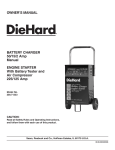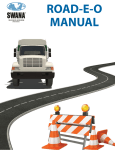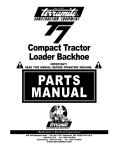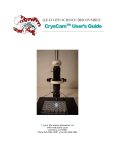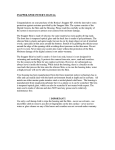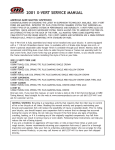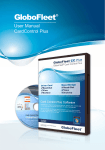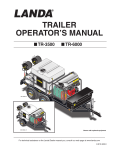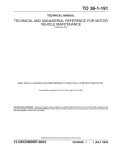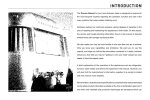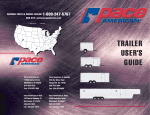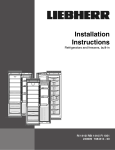Download Service Operations Manual
Transcript
Read Operators Manual For Safety PARTS MANUAL & Service Operations FIGURE 1 PARKING BRAKE DISENGAGED FIGURE 3 LOCK OUT HUB ENGAGED FIGURE 2 PARKING BRAKE ENGAGED FIGURE 4 LOCK OUT HUB DISENGAGED FIGURE 5 WATER TANK DRAIN USA 1.800.428.3772 Intl. 1 .304.776.4231 WWW.TERRAMITE.COM/SAFETY Copyright © 2007 Terramite Corporation Charleston, WV/USA 2.1 Read Operators Manual For Safety PARTS MANUAL & Service Operations Storing the Street Sweeper For Storage of More than 30 Days To insure maximum performance and minimum deterioration, the following procedures should be performed when the Terramite Street Sweeper will be idle for more than 30 days: 1. Wash the Terramite Street Sweeper and let dry (waxing will help prevent paint oxidation). 2. Change engine oil. 3. Charge battery fully and disconnect the battery leads. 4. Fill fuel tank within 2 inches of filler neck (keeps out condensation) and add fuel conditioner. 5. Squirt a small amount of oil into cylinders and crank the engine over a few times. 6. Grease all pivot pins. Liberally apply cup grease to all bare metal surfaces such as buckets and exposed cylinder rods. Grease all pivot pins. Retract all cylinder rods. Use WD40 on all electrical parts and areas inaccessible to regular grease. 7. Set the Terramite Street Sweeper on stands so the tires are off the ground. (Keeps tires from developing flat spots.) 8. Deflate tires to 1/2 pressure to relax cords. 9. Use a protective such as Armor All® on hoses, seat and tires to keep them from weathering 10. If the Terramite Street Sweeper is to be stored outside, cover with a tarp or plastic cover to minimize weathering. Engine Operating Instructions NOTE: With your Terramite Street Sweeper you will receive an Operation and Service Folder for the particular engine supplied with your machine. This manual contains detailed information as to operation, maintenance and repair of the engine and its various components. However, before attempting any major repair of the engine, contact your dealer or the factory as to whether it will affect your factory warranty. Before starting make sure that nobody is standing in the immediate vicinity of the engine or driven machine. 1. ENGAGE PARKING BRAKE 2. CHECK THAT MACHINE IS IN NEUTRAL 3. CHECK THAT BROOM ROTATION IS IN OFF POSITION Engine Fuel WARNING! Diesel fuel, although less explosive than gasoline, is highly flammable, and its vapors can explode under certain conditions. Store diesel fuel only in approved containers in unoccupied buildings and away from sparks or flames. Do not add diesel fuel while the engine is hot or running, or start the engine near spilled fuel. 2.2 WARNING! Do not activitate the starter for more than 20 seconds. If the engine does not catch, wait one minute then try again. WARNING! If engine does not start after 2 attempts, refer to operation manual supplied with the machine or call Terramite Service Technicians for assistance. Starting Kubota and Deutz Engines 1. Place key in ignition 2. Turn key clock wise to start position. 4. Release Key as soon as engine fires. WARNING! Do not activitate the starter for more than 20 seconds. If the engine does not catch wait one minute then try again. WARNING! If engine does not start after 2 attempts, refer to operation manual supplied with the machine or call Terramite Service Technicians for assistance WWW.TERRAMITE.COM/SAFETY Charleston, WV/USA Copyright © 2007 Terramite Corporation USA 1.800.428.3772 Intl. 1 .304.776.4231 Read Operators Manual For Safety PARTS MANUAL & Service Operations Engine Operating Instructions (continued) Do Not Use Ether as a Starting Aid CAUTION! The engine has a high compression ratio, and using ether will ruin your engine. The damage will not be covered under your warranty. Total Failure of Starter If the starter does not turn the engine over, shut off the starter immediately. Do not make further attempts to start the engine until the condition is corrected. CAUTION! Do not crank the engine continuously for more than 20 seconds at a time. If the engine does not start, allow a two minute cool-down period between starting attempts. Failure to follow these guidelines will burn out the starter motor. If the engine develops sufficient speed to disengage the starter but does not keep running (a “false start”), the engine rotation must be allowed to come to a complete stop before attempting to restart the engine, or engine damage may result. WARNING! Do not tamper with the governor setting to increase the maximum engine speed. Over-speeding is hazardous and will void the warranty. WARNING! Do not use JP4 Fuel or Ether The minimum centane number 45 (Aviation fuel) JP4 or either starting fluids must not be used. Weather Considerations Diesel Operation in Hot Weather Below 10 Degrees Operating the diesel engine in hot weather is mostly a matter of keeping the coolant at the correct level, the radiator clean and keeping an eye on the fan belt. Also, be certain of the viscosity of lubricants. Special procedures must be followed so your machine may be readily started without damage. The hydraulic system and the engine need to be fitted with electric heaters. The machine can be warmed with a high output forced air heater. Temperatures Below 32 Degrees There are several precautions which must be followed when the temperature drops below 32 degrees Fahrenheit. The oil in the engine and the hydraulic system needs to be changed to winter weight and a new oil and air filter should be considered. The battery should be kept at full charge. As starting may be more difficult, be sure that you do not run starter more than 20 seconds, followed by a two minute cooling off period. Do not hit the outside of the casing of the starter, as you may break the ceramic magnets. Fuel Conditioner For Diesel Engines Diesel fuel gets waxy at low temperatures and may not flow through the filter and pump at the normal rate of flow. Therefore, a good fuel conditioner additive is highly recommended for temperatures below 32 degrees Fahrenheit. USA 1.800.428.3772 Intl. 1 .304.776.4231 WWW.TERRAMITE.COM/SAFETY Copyright © 2007 Terramite Corporation Charleston, WV/USA 2.3 Read Operators Manual For Safety PARTS MANUAL & Service Operations Periodic Service General Considerations REQUIRED MAINTENANCE These required maintenance procedures should be performed at the frequency stated in the table. They should also be included as part of any seasonal tune-up. Perform these maintenance procedures more frequently when the engine is operated under extremely dusty or dirty conditions. Although your Terramite Street Sweeper is made of the finest and most durable materials, it will only hold up if given proper care. The maintenance procedures are very simple and easy to do. We have also included space in the back of this handbook for keeping a service record of your machine. IMPORTANT: See attached New Machine First Service Schedule for items that should be checked or serviced during the first 4 to 50 hours. Clean Air Intake Screen Daily Check Engine Oil Level Daily Check Hydraulic Oil Level Daily Check/Replace Fuel Filter** As Required Change Oil and Filter As Specified Clean Cooling Fins and External Surfaces 50 hrs. or as required **SEE ENGINE MAINTENANCE MANUAL FREQUENCY We also suggest that the air filter be checked weekly in the event you are working in extremely dirty or dusty conditions. The manufacturer’s air filter should be used, or warranty may be denied. Otherwise, check and clean monthly. Engine Oil Service Engine Oil (Recommended) Changing the Engine Oil Filter Refer to engine operating manual supplied with machine. Your Diesel is equipped with an oil filter. Replace the oil filter, in accordance with the “Oil Change Intervals” table. Always use a genuine OEM oil filter and replace as follows: Drain crankcase oil, then remove old filter. Before installing replacement filter, apply a thin coating of clean oil on the surface of the rubber seal. Turn filter clockwise until rubber seal contacts the filter adapter, then tighten filter an additional 2/3 to 3/4 turn. Add an additional 1/2 pint of oil for the filter capacity. Start the engine and check for oil leakage. Checking Engine Oil Before checking the oil, make sure the engine is stopped and resting on a level surface. Also, make sure the engine is cool and the oil has had time to drain into the sump. Bring the level up to, but not over, the full mark on the dip stick. Always check the level before adding more oil. CAUTION: Do not operate the engine above or below marked area on the dip stick. Changing Engine Oil For a new engine, change oil after the first 5 hours of operation, after that every 100 hours (50 if multi-viscosity oil is used). Drain oil while the engine is warm from operation. The oil will flow freely and carry away more impurities. Drain oil as follows: Remove the oil drain plug and oil fill cap. Dispose of the oil in a manner that meets Local, State and Federal regulations. Reinstall the drain plug. Make sure it is tightened securely. Be sure the engine is level when filling and checking oil. Then fill with new oil to the top line on the dipstick. Refer to engine operating manual for proper type. Always check the level on the dipstick before adding more oil. Reinstalled the oil fill cap and make sure it is tightened securely. 2.4 Extended Engine Oil Change Intervals NOTICE: Using other than the proper class oil or extending oil change intervals longer than recommended will cause engine damage which is not covered by the engine warranty. Engine Air Filter (Paper Element) The diesel engines are equipped with a high-density paper air cleaner element. The paper element should be replaced every 100 hours. Do not wash or use pressurized air to clean the paper element. Before installing new filter, be sure to inspect it for damage and that it fits perfectly when replaced. WWW.TERRAMITE.COM/SAFETY Charleston, WV/USA Copyright © 2007 Terramite Corporation USA 1.800.428.3772 Intl. 1 .304.776.4231 Read Operators Manual For Safety PARTS MANUAL & Service Operations Hydraulic System Service Check Hydraulic Oil Level Daily Before checking the hydraulic oil sight gauge, all cylinders should be retracted. The correct oil level is halfway up the sight gauge. To avoid damage to the hydraulic pumps, drain and replace milky-looking oil. Proceed as follows to drain the oil out of the reservoir tank. Hydraulic Oil Filter When the machine is new, the system oil and filter should be changed within the first 50 hours. After that, every 200 hours. Fill system with API SF/CD 10W below 40 degrees. Oil should be changed on a level surface. It is recommended that the oil be changed right after use while the oil is warm. Hydraulic Oil Leaks Can Be Dangerous WARNING! As this may be your first experience with a machine that functions primarily through hydraulic pressure, never inspect or put your hands close to any part of the hydraulic components of the machine while the engine is running or within two minutes after being shut down. If injured by escaping fluid, go to the emergency room of the nearest hospital at once and tell them the nature of the injury. If there is not a hospital in the vicinity, call a physician. Serious infection or a reaction such as gangrene can develop if proper medical treatment is not administered immediately. Minor Hydraulic Oil Leaks Oil leaks are often difficult to locate, as oil may leak from areas in the machine that are hidden from view. However, if you can locate the leak, take a cloth and completely dry everything around the leak to determine how fast the oil is escaping. A drop of oil every 10 seconds is only 1/2 oz. per hour. Do not use teflon tape to try to stop a leak, as it can get loose in the system. You can easily over tighten a fitting or hose wrapped with teflon, causing a housing to crack. The preferred sealant is Loktite™ hydraulic thread sealant with teflon paste. DANGER! Oil and Fittings Get Hot degrees. However, if the surface or hydraulic oil temperatures exceed these temperatures, it may be caused by having a control valve held open too long. Always return control valve to neutral when not in use. It could also indicate a low oil supply or contaminated oil. If low, refill. If contaminated, drain and refill with new oil, and replace filter. It could also indicate a kink or dent in a hose line or a worn pump. (See Service Manual for Pump replacement.) NOTE: Always make sure major leaks are contained and the oil disposed of in a proper manner. Stains on concrete may be removed by applying a mixture of oil dry and solvent. Let mixture set for a few hours before removal. Dispose of according to applicable Local/State/ Federal Laws. Changing the Hydraulic System Oil 1. Make sure all the cylinder rods are fully retracted. 2. Remove the sump line. 3. Remove the sump strainer, wash it in solvent, dry thoroughly. 4. Replace in reverse order. 5. Fill the system with recommended oil until it reaches the proper level. NOTE: There is no need to bleed the hydraulic system, the air will come out of the oil by itself. The machine may vibrate for a few minutes until the air purges. Be sure to dispose of your waste oil in a manner acceptable to Federal, State and local authorities. Some Tips on Hydraulic Hoses Inspect hoses regularly for nicks, cuts and wear. There are two wire braid layers under the rubber outer cover. When wire is exposed but undamaged, the hose still may be used, but should be replaced as soon as possible. If You Need New Hydraulic Hoses or Parts All hoses are JIC. Hoses may be obtained from Terramite Corporation or any industrial rubber supplier or hydraulic shop. Return the old hoses so they can match them. Short hoses may be made from the good portion of a damaged hose. It is normal for the hydraulic oil to reach 170 degrees; and the hydraulic hoses, cylinders and components, acting as a large passive radiator, can reach temperatures of over 200 USA 1.800.428.3772 Intl. 1 .304.776.4231 WWW.TERRAMITE.COM/SAFETY Copyright © 2007 Terramite Corporation Charleston, WV/USA 2.5 Read Operators Manual For Safety PARTS MANUAL & Service Operations Street Sweeper Lubrication Lubricating the Pivot Pins The most important single thing you can do to increase the life of the Terramite Street Sweeper is proper lubrication of the pivot pins. The pivot pins should be lubricated with a good lithium based grease every four hours of operation. Wipe dirt from the fittings before greasing. Replace any lost or damaged fittings immediately. to your machine. An ungreased pin will rust. The next time you use the machine the rust wears off, exposing more metal, which also rusts. The rust and dirt make a destructive grinding compound. Many people falsely blame the manufacturer for their own neglect in lubricating the machine. This is not covered under your warranty. Use Caution when Replacing Pins How to Ruin a Good Machine The first 20 hours of use are critical to the life of the machine. The pivot pins have minute edges which need to be broken in just as an automobile engines need to be broken in. If the pins are not adequately greased, they will break their retainers and work out, possibly causing damage When driving pivot pins in or out, use care to guard against injury from particles that may chip off the pin or object used in striking the pin. These pins can fly out at considerable speed if they are not tapped lightly just before they come out. Safety glassed must be worn. Battery and Tires Low Maintenance Battery Avoid High Tire Pressure Your Terramite Street Sweeper is equipped with a low maintenance battery. It uses a special construction to minimize water requirements. There is an “eye” on the battery to determine the conditions. Cold Weather Considerations NOTE: Cold weather makes a marginal battery useless. A battery fully charged at 80 deg. F. will have only 60% of its capacity at 32 deg. F., and only 40% at zero. A halfcharged battery has only 32% at 32 deg. F and 21% at zero. CAUTION! Excessive tire pressures increase the possibility of punctures and cause a rougher ride. The rim or tire could blow out, causing extreme injury or even death! Tire Traction and Hazards Avoid excessive wheel spin when loading. On most surfaces, wheel spin causes loss of traction and premature wear out of tires. Watch for hazards such as nails, glass, etc. Tire Pressures and Rim Size Titan - ST Radial 205/75R14 50PSI Cold -Load 1760 Lbs. Paint and Cleaning Protecting the Paint Because it is highly resistant to nearly everything, it requires little care. But constant exposure to sunlight will fade it just as other paints eventually fade. A coat of wax will help protect it. Leaving spilled diesel on your hood is not only an unsafe practice, but will cause stains and will 2.6 inevitably eat through your paint. Small scratches should be touched up or kept waxed to keep rust from attaching the metal under the paint. WWW.TERRAMITE.COM/SAFETY Charleston, WV/USA Copyright © 2007 Terramite Corporation USA 1.800.428.3772 Intl. 1 .304.776.4231 Read Operators Manual For Safety PARTS MANUAL & Service Operations Paint and Cleaning (continued) Paint Cleaning Solutions Fasteners (Nuts and Bolts) Some cleaning solutions and solvents used in high pressure washers may bleach the finish if used in high concentration or not rinsed from the machine. This can be avoided by diluting the cleaning solution or not letting it set too long. It is particularly important to check all nuts and bolts for tightness after the first 5 hours of use. All drive train bolts should receive extra attention. Thereafter, check every 250 hours. Trouble Shooting If a particular difficulty is experienced, check the symptoms listed below. Possible causes and remedies are given for each symptom. If the trouble is not corrected after following the suggested solution, call your dealer or call Terramite Corporation. Total Failure of Hydraulic Power (Engine is running, but nothing works) Stripped engine to transmission coupling. Must be replaced. Loss of Tram Power The hubs may be disengaged for towing. This will cause loss of tram power. This may indicate a worn transmission. Check with factory technician Loss of Sweeping Power Check for: 1. Low hydraulic oil. 2. Collapsed hose (hose can collapse internally, not showing any visible signs.) 3. Worn Pump. Check pump pressure. 4. Internal Valve leakage. Valves will sometimes develope leaks between the spools, yet not leak outside. Switching hoses to another valve will determine whether the valve section is bad. 5. Broken or weak relief valve. Check pressure. Check for fatigued or broken relief valve spring. All cylinders will lack power. You will have a little more power when your machine is cold. A weakened spring will lose power so gradually that you may not notice the decline in power until it seriously affects the machine performance. A broken spring will cause a sudden drop in cylinder power. USA 1.800.428.3772 Intl. 1 .304.776.4231 Sluggish and Slow Operation Oil still cold. Pump badly worn or damaged. Restriction in suction line. Clogged oil filter or sump strainer. Control Valve Sticks or Works Hard Normally, this is a problem for your dealer's service department. It is usually dirty valves, tie bolts too tight or float detent position adjusted too tight. Street Sweeper Doesn't Move in Either Direction If this happened over a period of time, the transmission is totally worn out. If it happened instantly, check for the following: 1. Make sure rear lock-outs are in. 2. Foot pedal disconnected. 3. Bolts broken on coupling. Transmission/Pump Makes Noise First check the oil viscosity. If too high, replace with specified oil. Then look for a kink or dent in oil lines. If not of these, it may be air in the system. See your dealer. Erratic Motion 1. Retract all rods and check hydraulic oil level. 2. Broken or weak pedal spring. 3. Worn transmission. Hydraulic Oil Foams 1. 2. 3. 4. 5. Low oil supply. Air leak in line from reservoir to pump. Incorrect hydraulic oil. Blocked valve restrictor. Check sump hose for tightness. WWW.TERRAMITE.COM/SAFETY Copyright © 2007 Terramite Corporation Charleston, WV/USA 2.7 Read Operators Manual For Safety PARTS MANUAL & Service Operations Trouble Shooting (continued) Hydraulic Oil Heats 1. Low oil supply. 2. Contaminated oil. 3. Control valve held open too long. None of the Problems Listed If the problem involves a part of the machine, such as the engine, transmission, hydraulic pump, etc., that is manufactured by someone other than Terramite Corporation, first check your service manual for more detailed information. If you do not find it there, contact your dealer or the original manufacturer's service department. For dealer locations, call Terramite Corporation at 1-800-428-3772 or International 1-304-776-4231. Wheel Drive Slow or Will Not Go 1. Drive motor seal failure may be checked by removing the plug on the rear wheel lock out. If there is any oil present the motor shaft seal has failed. 2. Check hydraulic pressure of transmission. Broom Rotation Stops or is Slow 1. Check Gear pump pressure using a portable hydraulic test box, test the GPM and PSI with the engine RPM at full throttle, the Gear Pump should produce from 9-1/2 to 10-1/2 GPM at 3,000 PSI. 2. To check broom motors individually, disconnect the 2 hoses to the motor and plug the hoses with steel caps. Install a jumper hose between the ports to eliminate leakage. 3. If the broom motor is not able to run the broom, remove the broom motor and make sure the square key on the broom motor shaft has not sheared. Setting the Auxiliary Hydraulic System Main Relief Valve 1. Install a 5,000 lb. pressure oil filled gauge in the outlet port of the relief valve. 2. Start the engine and set the throttle at full. Slowly turn the adjustment screw in (turn clockwise) until a consistent pressure of 3,000 PSI is reached. Lock down the lock nut and install the acorn cap on the screw and recheck the pressure. Main Pump Output Testing Use a hydraulic pressure gauge and a flow meter that measures both flow (GPM) and pressure (PSI). The transmission pump will produce 15 GPM and approximately 3,500 PSI with the engine set at full throttle. Machine Operation Control Location Purpose and Scope ITEM LOCATION FUNCTION 1. Seat Belt Left and right side of seat. 2. Parking/Emergency Brake Lever to left of seat. 3. Variable Speed Forward and to the right of the right foot position on the floorboard 4. F/R Valve Lever Located to the right of the operator seat. To prevent operator from falling off machine. To hold machine from rolling when parked and in neutral. To be used for emergency stopping of machine. Varies machine speed in forward and reverse when F/R Valve handle is actuated. A. Forward position allows machine to travel forward when variable speed pedal is depressed (See Item 4). B. Center position hydrostatically locks machine in park (be sure to also set Parking Brake). 2.8 WWW.TERRAMITE.COM/SAFETY Charleston, WV/USA Copyright © 2007 Terramite Corporation USA 1.800.428.3772 Intl. 1 .304.776.4231 Read Operators Manual For Safety PARTS MANUAL & Service Operations Machine Operation Control Location (continued) ITEM LOCATION 5. Keyswitch Centrally located below the steering wheel. 6. Broom Rotary Located to the right of the steering wheel. 7. Broom Left-To-Right Located to left of and furthest from the steering wheel. 8. Broom Lift Control Located to left of and closest to the steering wheel. 9. Engine Throttle To right of and below the steering wheel. FUNCTION C. Rear position allows unit to travel in reverse when the variable speed pedal is depressed (See Item 4). Preheats engine glow plugs when turned and held in full left position, starts engine when turned and held in full right position. 1st "Notch" positions from full right is "Run", and 2nd "Notch" position from full right is "Off". (On Kubota ONLY) When pushed forward broom sweeps forward, when in center position, broom stops. Variable speed rotation. When pushed forward, right end of broom moves towards rear when pulled back, right end of broom moves forward. When pushed all the way forward and locked into detented position, broom head goes to lowered and operating float position. When lever is pushed forward broom head raises off of surface. To set engine operating speed. Lubrication and Maintenance Chart ITEM DESCRIPTION/LOCATION MAINTENANCE SCHEDULE 1. Grease Fittings a. (2) Bearing on Front Fork b. (1) Variable-Speed-Pedal under floorboard c. (2) Left and Right on Brake Rod d. (1) Foot Brake Grease all fittings daily 2. Hydraulic Oil With oil hot, oil level should be in center of eye on side of hydraulic tank and/or 1" below top of tank. Capacity: 20 Gallons Change Hydraulic Oil every 6 months or as needed. 3. Hydraulic Spin-On Filters a. 10 Micron Part #21002 2 under floorboard. b. Hydraulic Tank Screen Part #38072 at rear of Hydraulic Tank. c. High Pressure Filter Element Part #38019 inside hood and to right of engine. Change both Spin-On filters every 3 months. Remove and clean every 6 months. USA 1.800.428.3772 Intl. 1 .304.776.4231 Change every 6 months. WWW.TERRAMITE.COM/SAFETY Copyright © 2007 Terramite Corporation Charleston, WV/USA 2.9 Read Operators Manual For Safety PARTS MANUAL & Service Operations Lubrication and Maintenance Chart (continued) ITEM DESCRIPTION/LOCATION MAINTENANCE SCHEDULE 4. Engine Oil Engine Oil Type: Refer to Engine Manufacturers Operations Manual. Change Engine oil and all filters, air, spin-on fuel, in-line fuel, and oil every 150 hours. 5. Radiator Water/Antifreeze Strictly 50% water and 50% permanent Antifreeze mixture only!!!! Check mix and level. Level to be 1/2 full in plastic over-fill tank. 6. Tire Pressure 45 PSI to 50 PSI Check Daily. 7. Water Filters Under Floorboard, Water Tanks Clean as Needed 8. Front Wheel Bearings Front Wheel inside and outside. Repack monthly. 9. Fuel Tank Drain Pipe plug located in center of and at bottom of fuel tank. Drain once a year. Between wheel and frame. Remove female hex plug on front or back of housing to check. Capacity: 6 Ounces Motor Oil: SW 30 Wt. Detergent Check every 3 months. 10. Wheel Lock-Out Oil Level Service and Maintenance Points All references to "Left" or "Right" side of the Terramite Street Sweeper are stated as from the Operators seat facing forward. Anti-Freeze Mix Liquid cooled engines are very sensitive to the water/ antifreeze mix. To much of either water or antifreeze will cause engine overheating. The proper mix is 50% water and 50% antifreeze. Air cooled engines have no need for anti-freeze. Machine Trouble Shooting & Hydraulic Component Check-Out Before testing any hydraulic component always check the hydraulic oil level. Bring the hydraulic oil temperature up to 20° over Ambient. Place the machine on a flat surface. 2.10 The hydraulic oil level should be in center of the "Eye" indicator and/or not more than 1" below the top surface of hydraulic oil tank. WWW.TERRAMITE.COM/SAFETY Charleston, WV/USA Copyright © 2007 Terramite Corporation USA 1.800.428.3772 Intl. 1 .304.776.4231 Read Operators Manual For Safety PARTS MANUAL & Service Operations Proper Care and Use of Broom Wafers Factors for Longer Brush Life. Broom Storage The broom portion of the Terramite Street Sweeper should be stored away from direct sunlight. Prolonged exposure to sunlight greatly reduces the life of the bristles. Do not leave broom head lowered with weight on the bristles when not in use. Weight on the bristles for long periods of time will cause the bristles to become permanently deformed, resulting in lowered sweeping effectiveness. 1/2 Poly - 1/2 Wire Wafers (Standard) 1/2 Poly and 1/2 Wire Wafers are used for varying sweeping conditions. The 1/2 and 1/2 combination is used to sweep throughout the year without changing cores. This combination is the most used approach. Eight foot brooms require 24 poly and 23 wire wafers and six foot brooms require 19 poly and 18 wire wafers Poly Wafers For normal sweeping operations, such as sand, dirt, paper, etc. This wafer will be the best for dry sweeping. Maximum 3" brush pattern. Wire Wafers For hard material sweeping, such as concrete curing, mud, rock, snow, etc. This wafer is the strongest wafer available and with the sharpest cutting force. For snow usage the ends pierce the snow and ice quicker than poly wafers. This quickness requires less down pressure. Maximum 3" brush pattern. Exceeding this pattern will lead to wire breakage, excessive wire wear, and short life of the wafers. 1. BROOM LEVEL A broom not level with the sweeping surface may cut wafer life in excess of 50%. For maximum broom wafer life the level of the broom must be checked daily. The time spend in checking and correcting the broom level will pay in the extended life of the broom wafers. 2. TURNING BROOM CORE Turning the broom core from end to end during the life of the brush will also extend its life. This turning helps prevent uneven wear caused by sweeping material from the same side, refer to page 2.17. 3. BRUSH DOWN PRESSURE The most common reason for short brush life is too much down pressure. By using the proper amount you can obtain maximum brush life. The best sweeping action occurs by the "flicking" action of the bristles at their tips. By applying too much down pressure the bristles are using their "sides", this action greatly accelerates wear and reduces sweeping efficiency. To limit down pressure, Terramite Street Sweepers are equipped with an adjustable spring assembly. Proper adjustment is shown in Figure 1. 4. PROPER GROUND SPEED Proper ground speed is important for the life of the brush. Running the machine too fast may allow material to accumulate in front of it. This build up of material creates pressure on the bristle "sides", which leads to their "wear". For proper operation, sweep at high enough brush speed to discharge material and with proper ground speed to discharge the swept material from the sweepers path. Brush Wafer Wear Life The brush is one of the most important parts of the sweeper and its operations. The brush is a replaceable component that literally performs the hard work. EXAMPLE OF WEAR LIFE Fine Asphalt ............................................................................. 1 Year Finish Coated Asphalt ............................................................ 6 Mos. 1st Pass Asphalt ................................................................. 3-4 Mons. Milling (Ground up road surface) ....................................... 1 week These number will be greatly reduced if used in an incorrect manner. USA 1.800.428.3772 Intl. 1 .304.776.4231 RIGHT WRONG FIGURE 1 Brush Setting Decal and Proper Brush Setting WWW.TERRAMITE.COM/SAFETY Copyright © 2007 Terramite Corporation Charleston, WV/USA 2.11 Read Operators Manual For Safety PARTS MANUAL & Service Operations Broom Core Removal/Wafer Replacement 1. 2. 3. 4. 5. 6. 7. 8. 9. 10. 11. Place sweeper in level spot. Engage parking brake Turn off engine. Clean the broom head. Lower the sweeper head until the bristles just touch the surface. Remove the 3 bolts (Shown as “A” in Figure 1). Remove the bolt (Shown as “B” in Figure 1). Pull the motor assembly from the brush core and lay it to the side. DO NOT REMOVE ANY HOSES! Start the sweeper at low idle. Raise the broom head enough to allow the core to be completely removed. Turn off engine. If turning the broom for brush life, rotate broom core and skip to step. 16. Remove the (2) screws and cap plate (Shown as “A” in Figure 2). A A B FIGURE 1 FIGURE 2 FIGURE 5 Proper Placement of Wafers on Core FIGURE 4 Improper Placement of Drive Pins (Circled) 2.12 12. Remove wafers. 13. Place a wafer onto the core with the drive pins between the tube (Shown in Figure 3 for proper placement and Figure 4 for improper placement). 14. The next wafer is flipped as it is placed over the core and rotated 1/3 turn (Shown in Figure 4 for proper placement and Figure 5 for improper placement). NOTE: To have proper number of wafers it may be necessary to tap them with a heavy rubber hammer. NOTE: For 1/2 wire and 1/2 poly place a poly wafer on each end. 15. Reattach the end cap. 16. Place broom core into broom head. 17. Reattach the motor assembly. 18. Check for proper operation. WWW.TERRAMITE.COM/SAFETY Charleston, WV/USA Copyright © 2007 Terramite Corporation FIGURE 3 Proper Placement of Drive Pins (Circled) FIGURE 6 Improper Placement of Wafers on Core USA 1.800.428.3772 Intl. 1 .304.776.4231 Read Operators Manual For Safety PARTS MANUAL & Service Operations Setting and Adjusting Broom 1. Set the broom angle to that needed. (See Figures 1, 2 and 3). 2. Set broom level. (See Figure 4). Loosen the 3/4 lock nuts. (See Figure 5). Raise or lower broom TOP VIEW motor to obtain consistant brush contact across full length of the broom. 3. Adjust broom contact. (See Figure 6). TOP VIEW FIGURE 1 Angled Right TOP VIEW FIGURE 2 Angled Left FIGURE 4 Horizontal Level FIGURE 3 Straight FIGURE 5 Lock Nut - Left Side (Circled) RIGHT WRONG FIGURE 6 - Brush Setting Decal and Example of Proper Brush Setting USA 1.800.428.3772 Intl. 1 .304.776.4231 WWW.TERRAMITE.COM/SAFETY Copyright © 2007 Terramite Corporation Charleston, WV/USA 2.13













